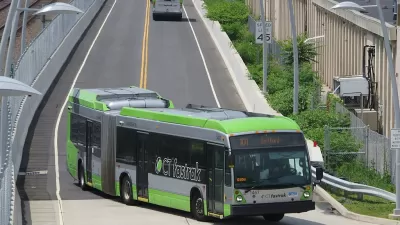A case study of media coverage in Connecticut finds a double standard between the CTFastrak and Interstate 84 projects.
Joseph Cutrufo examines the discrepancies in the scrutiny afforded two transit projects in Connecticut: CTfastrak and the widening of Interstate 84 in Waterbury. Cutrufo begins by noting the similarities between the two projects: "They’re both major transportation projects aimed at improving mobility, both became visible to the traveling public in the spring of 2015, and both cost hundreds of millions of dollars."
Yet despite those similarities, "it seems that the Connecticut Department of Transportation is being asked to justify the amount it’s spending on the bus rapid transit service, while spending on major highway projects seems to be accepted without much media scrutiny."
Seemingly opposed to the CTFastrak, is the Hartford Courant, which has reported and editorialized about a large jump in costs for the system. Cutrofo, however, thinks the focus on increased costs misses much of the point:
"It’s a substantial increase, but that original subsidy estimate is eight years old (though ConnDOT Commissioner Redeker probably shouldn’t have been 'quoting the $10 million figure with no caveats or disclaimers' as recently as 2014 — good sleuthing by the Courant). Since then, ConnDOT had expanded its service plan, which makes the system more useful and convenient, which in turn drives up ridership. And it’s working. Average daily ridership, according to the same article, is over 16,000, about 50 percent higher than the expected 11,200 daily riders."
The article includes by noting the lack of analysis or critique for the 2.7-mile widening project on I-84. In effect, according to Cutrofo, the media and the public declare the following: "No more bottleneck? By any means necessary! More money to subsidize bus riders? Let’s see your numbers."
FULL STORY: Scrutiny for Transit Projects, but Not for Highways

Maui's Vacation Rental Debate Turns Ugly
Verbal attacks, misinformation campaigns and fistfights plague a high-stakes debate to convert thousands of vacation rentals into long-term housing.

Planetizen Federal Action Tracker
A weekly monitor of how Trump’s orders and actions are impacting planners and planning in America.

In Urban Planning, AI Prompting Could be the New Design Thinking
Creativity has long been key to great urban design. What if we see AI as our new creative partner?

King County Supportive Housing Program Offers Hope for Unhoused Residents
The county is taking a ‘Housing First’ approach that prioritizes getting people into housing, then offering wraparound supportive services.

Researchers Use AI to Get Clearer Picture of US Housing
Analysts are using artificial intelligence to supercharge their research by allowing them to comb through data faster. Though these AI tools can be error prone, they save time and housing researchers are optimistic about the future.

Making Shared Micromobility More Inclusive
Cities and shared mobility system operators can do more to include people with disabilities in planning and operations, per a new report.
Urban Design for Planners 1: Software Tools
This six-course series explores essential urban design concepts using open source software and equips planners with the tools they need to participate fully in the urban design process.
Planning for Universal Design
Learn the tools for implementing Universal Design in planning regulations.
planning NEXT
Appalachian Highlands Housing Partners
Mpact (founded as Rail~Volution)
City of Camden Redevelopment Agency
City of Astoria
City of Portland
City of Laramie




























